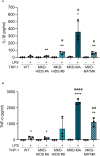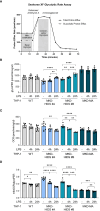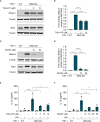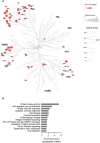Mevalonate kinase-deficient THP-1 cells show a disease-characteristic pro-inflammatory phenotype
- PMID: 38550596
- PMCID: PMC10972877
- DOI: 10.3389/fimmu.2024.1379220
Mevalonate kinase-deficient THP-1 cells show a disease-characteristic pro-inflammatory phenotype
Abstract
Objective: Bi-allelic pathogenic variants in the MVK gene, which encodes mevalonate kinase (MK), an essential enzyme in isoprenoid biosynthesis, cause the autoinflammatory metabolic disorder mevalonate kinase deficiency (MKD). We generated and characterized MK-deficient monocytic THP-1 cells to identify molecular and cellular mechanisms that contribute to the pro-inflammatory phenotype of MKD.
Methods: Using CRISPR/Cas9 genome editing, we generated THP-1 cells with different MK deficiencies mimicking the severe (MKD-MA) and mild end (MKD-HIDS) of the MKD disease spectrum. Following confirmation of previously established disease-specific biochemical hallmarks, we studied the consequences of the different MK deficiencies on LPS-stimulated cytokine release, glycolysis versus oxidative phosphorylation rates, cellular chemotaxis and protein kinase activity.
Results: Similar to MKD patients' cells, MK deficiency in the THP-1 cells caused a pro-inflammatory phenotype with a severity correlating with the residual MK protein levels. In the MKD-MA THP-1 cells, MK protein levels were barely detectable, which affected protein prenylation and was accompanied by a profound pro-inflammatory phenotype. This included a markedly increased LPS-stimulated release of pro-inflammatory cytokines and a metabolic switch from oxidative phosphorylation towards glycolysis. We also observed increased activity of protein kinases that are involved in cell migration and proliferation, and in innate and adaptive immune responses. The MKD-HIDS THP-1 cells had approximately 20% residual MK activity and showed a milder phenotype, which manifested mainly upon LPS stimulation or exposure to elevated temperatures.
Conclusion: MK-deficient THP-1 cells show the biochemical and pro-inflammatory phenotype of MKD and are a good model to study underlying disease mechanisms and therapeutic options of this autoinflammatory disorder.
Keywords: autoinflammatory disorders; cytokines; hyper IgD syndrome; innate immune response; isoprenoid biosynthesis; mevalonate kinase deficiency.
Copyright © 2024 Politiek, Turkenburg, Ofman and Waterham.
Conflict of interest statement
The authors declare that the research was conducted in the absence of any commercial or financial relationships that could be construed as a potential conflict of interest.
Figures








Similar articles
-
Molecular and cellular consequences of mevalonate kinase deficiency.Biochim Biophys Acta Mol Basis Dis. 2024 Jun;1870(5):167177. doi: 10.1016/j.bbadis.2024.167177. Epub 2024 Apr 16. Biochim Biophys Acta Mol Basis Dis. 2024. PMID: 38636615
-
Identification of FDA-approved drugs that increase mevalonate kinase in hyper IgD syndrome.J Inherit Metab Dis. 2024 Mar;47(2):302-316. doi: 10.1002/jimd.12698. Epub 2023 Dec 22. J Inherit Metab Dis. 2024. PMID: 38131282
-
Mutational spectrum and genotype-phenotype correlations in mevalonate kinase deficiency.Hum Mutat. 2006 Aug;27(8):796-802. doi: 10.1002/humu.20361. Hum Mutat. 2006. PMID: 16835861
-
Compromised Protein Prenylation as Pathogenic Mechanism in Mevalonate Kinase Deficiency.Front Immunol. 2021 Sep 3;12:724991. doi: 10.3389/fimmu.2021.724991. eCollection 2021. Front Immunol. 2021. PMID: 34539662 Free PMC article. Review.
-
Current advances in the understanding and treatment of mevalonate kinase deficiency.Int J Immunopathol Pharmacol. 2014 Oct-Dec;27(4):491-8. doi: 10.1177/039463201402700404. Int J Immunopathol Pharmacol. 2014. PMID: 25572728 Review.
References
Publication types
MeSH terms
Substances
LinkOut - more resources
Full Text Sources
Molecular Biology Databases

